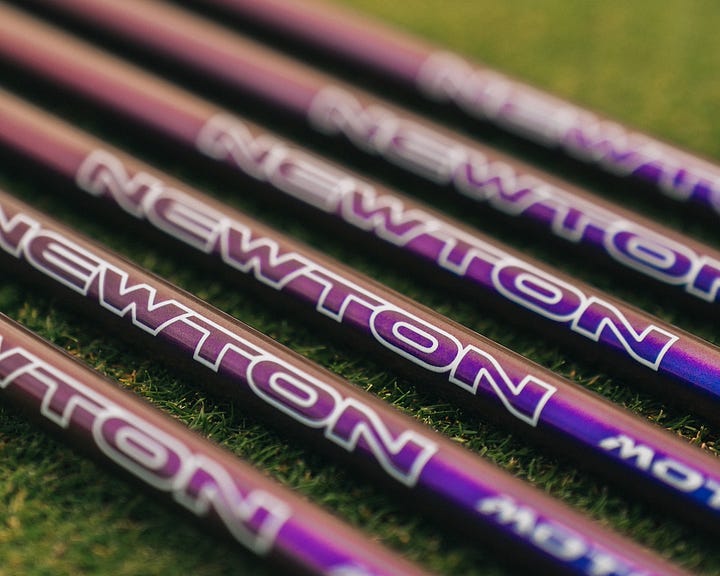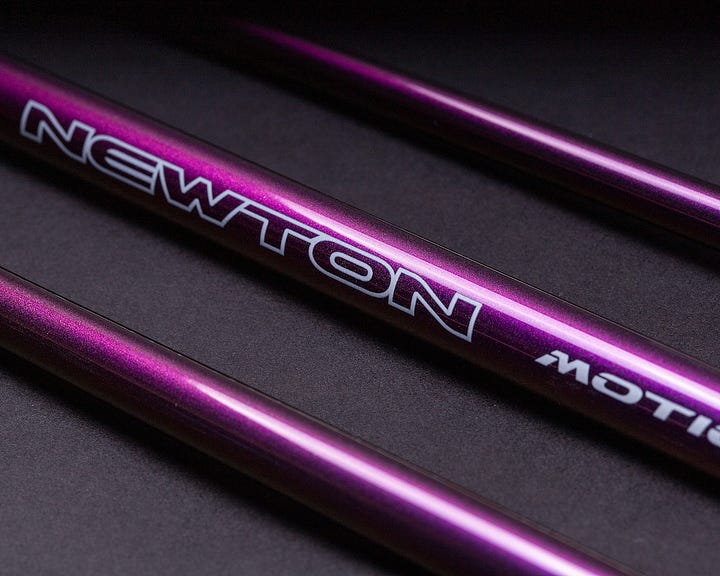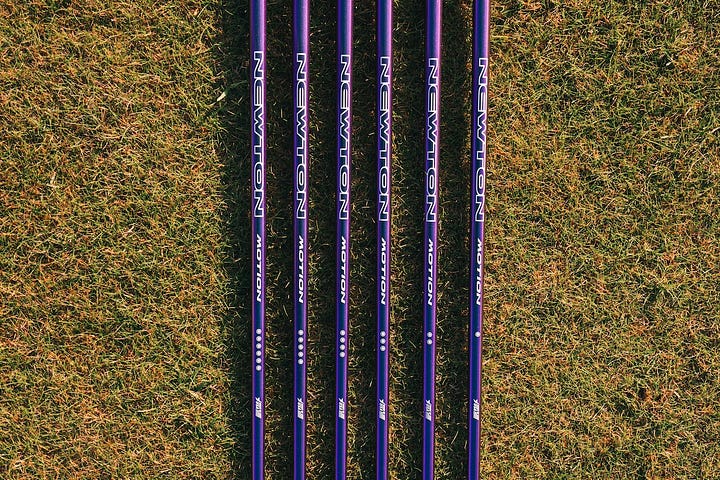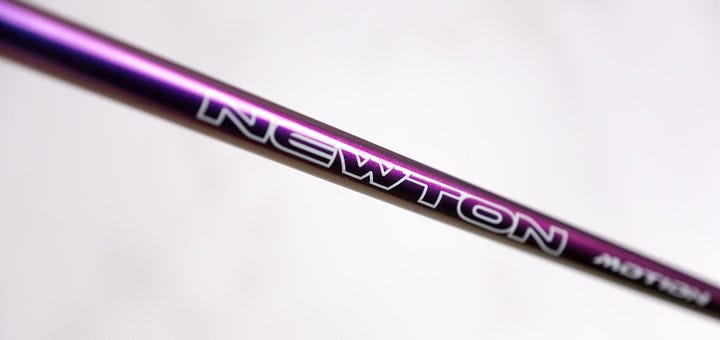Sir Isaac Newton and the quest for distance
The Newton Motion carbon fiber shaft is adding considerable yardage for the fraction of what a new driver would cost — and that has the author's undivided attention
Welcome to “In Search of Distance,” starring me and every other senior golfer in the world. It’s a reality show that — spoiler alert — probably won’t have a happy ending.
My fellow geezers and I are stubborn you-know-whats. We won’t give up. And forget the ball rollback coming at the end of this decade. We seniors don’t plan that far ahead. Hey, we’re already careful about buying bananas that aren’t too green, if you get my drift.
On the golf course, we’re all desperately seeking more length off the tee, somehow, some way, by hook or by tech. Because with each passing year, our tee shots go a little shorter no matter how much we stretch and work out. My feeling about that is the same as what Gen. Anthony McAuliffe told the Germans in World War II after they asked him to surrender in Bastogne during The Battle of the Bulge: “Nuts!”
Back to 2024, where Sacks Parente Golf feels our pain. It has expanded its golf division from putters and high-tech putter shafts into driver shafts, grips and accessories. The new Newton Motion driver shaft, a proprietary design made from carbon fiber, has my full attention.
In my quest for distance, I installed a South Korean Autoflex shaft in my driver two summers ago and gained 12 yards of carry. It is a counterintuitive shaft. It is very light, weighs only 45 grams and is almost as bendy as a fishing rod. I thought, I’m going to snap-hook this thing into the weeds. Nope, Autoflex actually goes straighter and farther — the aforementioned 12-yard gain. Having just become eligible for Medicare, the Mason-Dixon demarcation line for senior citizens, I really needed that 12 yards. I paid $780 for that shaft, which I consider almost magical. (The shaft, not the 780 bucks). Regrets? Just the opposite. I also put an Autoflex shaft in my 3-wood last summer and it was nearly life-changing.
The Newton Motion shaft is in the same ballpark. The timing is right, what with that ball rollback lurking in the future, and Newton Motion is in the right place. With no offense to Mr. Autoflex, Newton Motion comes at a better price — $250.
“I can probably get you that 12 yards for $250,” says Mike Ferris, the company’s chief strategy growth officer. “We have people putting it in their driver who are getting 15 or 18 more yards. You can pay $250 for a new shaft versus $599 for a new driver. That’s a value prospect.”
— — — — — — —
MORE FROM GARY VAN SICKLE
> Hey, Mr. Van Sickle, I have a question
> And the winners are ... not who you think
> Tiger plays, we watch. Tiger speaks, we listen
> Curiosity about the state of Tiger Woods is high
> Tiger, Tiger, Tiger ... it's Tiger time
> LIV Golf players want rankings? Well, here you go
— — — — — — —
A lot of seniors, and a lot of golfers in general, aren’t using shafts they were fitted for. They’re just hitting whatever club they have. Some seniors (such as myself) need to give up the strong flex shaft they used the last 20 years and gear back to regular stiffness. Which is another reason the Newton Motion works so well, it’s easier to swing. Plus, you could outfit three woods with Newton Motions for the price of one Autoflex shaft. Luckily, I was able to type that last sentence without tears rolling down my cheeks …. not that I’m cheap or anything.
“When we applied our technology to the driver shaft, we thought we could tackle the best in the business,” says Aki Yorihiro, Newton Motion’s chief technology officer. “We dissected all the shafts out there. Many are quite good. Fujikura Ventus, Graphite Design. Those are very good shafts. They test very well. Those are our targets. I want to beat those guys.
“I can choose what I want to do and what excites me is something that’s great, something noticeably better. Doing the same thing the others are doing does not excite me.”
Yorihiro calls himself “a recovering lawyer,” a description that makes him immediately likable. He explained the secret sauce of what makes the Newton Motion shafts work. It is what the company calls “backbone technology.”
Normally, a golf shaft has a spine created during manufacturing — a spot where the shaft isn’t perfectly round or the wall thickness isn’t uniform all the way around the shaft. This led to a clubfitting process called “spine-ing,” in which the spine is identified and oriented into the clubhead in an optimal position. The problem is, since most driver and fairway woods are adjustable, that optimal spine-ing position gets lost as soon as a player changes the clubhead settings. Newton Motion shafts are manufactured to such a high degree of exactness that they don’t have spines.
The talk about spines may be more technical than you want to get, so Yorihiro makes it simpler: “When we did robot testing, the Ventus Blue shaft was definitely stiff competition. Generally speaking, our shaft is slightly more efficient because its bend profile is more elongated and less concentrated. It is lower on spin and with less kicking. It stores more energy so it’s a gradual kick versus a violent kick. A violent kick generates spin. That’s the difference between Newton Motion and Ventus.”
I performed my own unscientific testing, taking a few Newton Motion shafts to No Off-Season, an indoor simulator facility with Trackman technology in Mars, Pennsylvania. It was unscientific because I’m the opposite of the robot that makes every swing the same. For better insight, I included someone who’s a lot more consistent than me — my son, Mike Van Sickle, a former card-carrying Korn Ferry Tour player who teaches at No Off-Season. Another disclaimer is that we tested in January, when my swing is at its least-honed.
I started with a Titleist Ts2 driver, 10.5 degrees loft, and a Ventus Blue stiff shaft. The drives I hit decent — there’s no point in counting the hideous ones — fell between 91 and 93 mph of clubhead speed and 136 to 139 mph ballhead speed. The carry distance was 216 to 221, with one outlier at 227 that rolled out to 257 according to Trackman data.
I installed the Newton Motion shaft in the same head and got similar clubhead speed numbers, though one bumped up to 93.6. My ballspeeds were incrementally better, around 137, with 141 off that 93.6-mph clubhead speed drive. The carry distances were 223 to 226 with one at 238. Newton Motion beat the Ventus for me.
Newton Motion came pretty close to matching my Autoflex shaft. I was around 93 mph clubhead speed with Autoflex, 137-138 ball speed with carry distances of 221-226, rollouts into the mid-250s. I’d give Autoflex a slight edge in this duel due to marginally better directional consistency.
Mike’s numbers were probably more relevant because his ballspeed numbers don’t change much from shot to shot.
He used a Cobra AirJet driver adjusted to 9.0 degrees of loft with a Ventus Blue extra stiff shaft and averaged between 118.8 and 120.2 mph clubhead speed, 176-179 ball speed with carry distance of 302 yards and rolling out to between 316 and 325 yards.
Mike put the Newton Motion 6-dot shaft in the same Cobra AirJet head and got similar numbers, 118.4 to 120.8 clubhead speed; 170.8 to 174.6 ball speed and carry distance between 296 and 303.
“The Newton Motion is very comparable to Ventus,” Mike says. “I wouldn’t say it was better than Ventus, though. There might be a little more work to do there. Could I put it I play tomorrow? Absolutely.”




Newton Motion uses dots instead of the usual regular, stiff, extra-stiff words to rate its stiffness. They’re based on swing speeds. One dot, 75 mph swing speeds or less; two dots, 75-85; three dots, 85-95; four dots, 95-105; five dots, 105-115; six dots, 115-plus. The shafts are manufactured in Missouri using Japanese materials.
For now, the shafts are available at NewtonShafts.com. The shafts are sold “ready to play” with a shaft adapter and a Lamkin grip included. Simply unscrew your current shaft, insert a Newton Motion, lock it tight and start swinging.
“We named the shaft business for Sir Isaac Newton’s Laws of Motion,” Ferris says. “We think picking a shaft should be based on physics, not on gender or age bias. I’m a senior now but I don’t want a senior shaft. I know what I am. We want consumers to make a good shaft selection on our website so we ask, ‘What is your average drive in yards?’ Or, ‘What is your swing speed?’ And we also recognize that everybody exaggerates how far they hit a golf ball.’ We want to appeal to everybody. So this is an every-persons shaft.”
One last unique thing about the Newton Motion shaft is its color. The shaft has a shimmering look that changes in light between green and purple and assorted hues in between.
I like shiny new things. Especially shiny new things that might give me a few extra yards off the tee because I’m not getting any younger. You?


Thx for reading, Paul. I hope you get shafted soon... er, that didn't sound right!
Hello friend, I’ve noticed we have similar interests so I thought I’d introduce myself with a article.
This one is on the Aether, and the Monad:
https://open.substack.com/pub/jordannuttall/p/the-reality-of-the-ther?r=4f55i2&utm_medium=ios